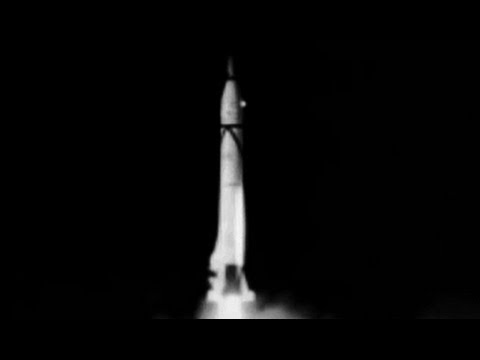more at
“Blockhouse intercom recording from the Explorer I launch on 31 January 1958 superimposed with a slide show of photographs of the event.”
Public domain film from the US Air Force, slightly cropped to remove uneven edges, with the aspect ratio corrected, and mild video noise reduction applied.
The soundtrack was also processed with volume normalization, noise reduction, clipping reduction, and/or equalization (the resulting sound, though not perfect, is far less noisy than the original).
Explorer 1 (1958 Alpha 1) was the first Earth satellite of the United States, launched as part of its participation in the International Geophysical Year. The mission followed the first two Earth satellites the previous year, the Soviet Union’s Sputnik 1 and 2, beginning the Cold War Space Race between the two nations.
Explorer 1 was launched on January 31, 1958 at 22:48 Eastern Time (equal to February 1, 03:48 UTC) atop the first Juno booster from LC-26 at the Cape Canaveral Missile Annex, Florida. It was the first spacecraft to detect the Van Allen radiation belt, returning data until its batteries were exhausted after nearly four months. It remained in orbit until 1970, and has been followed by more than 90 scientific spacecraft in the Explorer series…
Background
The U.S. Earth satellite program began in 1954 as a joint U.S. Army and U.S. Navy proposal, called Project Orbiter, to put a scientific satellite into orbit during the International Geophysical Year. The proposal, using a military Redstone missile, was rejected in 1955 by the Eisenhower administration in favor of the Navy’s Project Vanguard, using a booster produced for civilian space launches. Following the launch of the Soviet satellite Sputnik 1 on October 4, 1957, the initial Project Orbiter program was revived as the Explorer program to catch up with the Soviet Union.
Explorer 1 was designed and built by the Jet Propulsion Laboratory (JPL), while a Jupiter-C rocket was modified by the Army Ballistic Missile Agency (ABMA) to accommodate a satellite payload; the resulting rocket known as the Juno I. The Jupiter-C design used for the launch had already been flight-tested in nose cone reentry tests for the Jupiter IRBM, and was modified into Juno I. Working closely together, ABMA and JPL completed the job of modifying the Jupiter-C and building Explorer 1 in 84 days. However, before work was completed, the Soviet Union launched a second satellite, Sputnik 2, on November 3, 1957. The U.S. Navy’s attempt to put the first U.S. satellite into orbit failed with the launch of the Vanguard TV3 on December 6, 1957.
Spacecraft design
Explorer 1 was designed and built by the California Institute of Technology’s JPL under the direction of Dr. William H. Pickering. It was the second satellite to carry a mission payload (Sputnik 2 was the first).
The total weight of the satellite was 13.37 kilograms (30.80 lb), of which 8.3 kg (18.3 lb) were instrumentation. In comparison the first Soviet satellite Sputnik 1 weighed 83.6 kg (184 lb). The instrument section at the front end of the satellite and the empty scaled-down fourth-stage rocket casing orbited as a single unit, spinning around its long axis at 750 revolutions per minute…
Flight
The Juno I rocket was launched January 31, 1958, putting Explorer 1 into orbit with a perigee of 358 kilometers (222 mi) and an apogee of 2,550 kilometers (1,580 mi) having a period of 114.8 minutes. At about 1:30 a.m. ET, after confirming that Explorer 1 was indeed in orbit, a news conference was held in the Great Hall at the National Academy of Sciences in Washington, DC to announce it to the world.
Mercury batteries powered the high-power transmitter for 31 days and the low-power transmitter for 105 days. Explorer 1 stopped transmission of data on May 23, 1958 when its batteries died, but remained in orbit for more than 12 years. It reentered the atmosphere over the Pacific Ocean on March 31, 1970 after more than 58,000 orbits…
Sometimes the instrumentation would report the expected cosmic ray count (approximately 30 counts per second) but sometimes it would show a peculiar zero counts per second. The University of Iowa (under Van Allen) noted that all of the zero counts per second reports were from an altitude of 2,000+ km (1,250+ miles) over South America, while passes at 500 km (310 mi) would show the expected level of cosmic rays. Later, after Explorer 3, it was concluded that the original Geiger counter had been overwhelmed (“saturated”) by strong radiation coming from a belt of charged particles trapped in space by the Earth’s magnetic field. This belt of charged particles is now known as the Van Allen radiation belt. The discovery was considered to be one of the outstanding discoveries of the International Geophysical Year…

